|
|
|
|
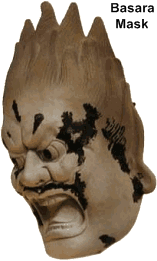 
Jūni Shinshō, Juni Shinsho
Twelve Heavenly Generals of Yakushi Buddha
Jūni Shinshō 十二神将
Also known as Jūni Shinnō 十二神王
or Jūni Yakusha Taishō 十二薬叉大将
Attendants to Yakushi Nyorai | Members of the Tenbu
Members of the Hachibushu | Members of the Yasha
Drawings of the 12 Generals | More Photos of the 12
Origin - India
The 12 Heavenly Generals protect and serve Yakushi Nyorai (the Medicine Buddha). The twelve are Hindu Yasha 夜叉 (Skt. = Yakṣa or Yaksha) who were later incorporated into Buddhism as protective warriors. In Japanese sculpture and art, they are almost always grouped in a protective circle around Yakushi Nyorai -- they are rarely shown independently. Many say they represent the twelve vows of Yakushi; others say the 12 were present when the Historical Buddha introduced the “Healing Sutra;” yet others that they offer protection during the 12 daylight hours, or that they represent the 12 months and 12 cosmic directions, or the 12 animals of the 12-year Chinese zodiac. The Jūni Shinshō are also members of the Tenbu (Sanskrit: Deva), a larger grouping of deities protecting the Buddhist realm.
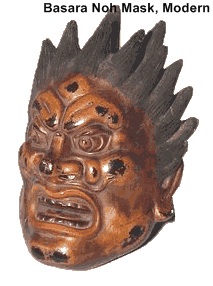 While interpretations differ, the Jūni Shinshō are always depicted with fierce facial expressions and menacing martial stances. They usually wear armour, topped off with a helmet or spiked hair. Their main function is to protect Yakushi Nyorai, to protect those who read/believe in Buddhist writings that expand faith in Yakushi, to fight the enemies of Buddhism, and to wage war on sickness -- they are said to command the 84,000 pores (some resources say 80,000) of the skin in defending the health of the faithful. Their ferocious expressions represent their anger with evil deeds and evil people. While interpretations differ, the Jūni Shinshō are always depicted with fierce facial expressions and menacing martial stances. They usually wear armour, topped off with a helmet or spiked hair. Their main function is to protect Yakushi Nyorai, to protect those who read/believe in Buddhist writings that expand faith in Yakushi, to fight the enemies of Buddhism, and to wage war on sickness -- they are said to command the 84,000 pores (some resources say 80,000) of the skin in defending the health of the faithful. Their ferocious expressions represent their anger with evil deeds and evil people.
Yakushi Nyorai, along with his 12 attendants, arrived early in Japan (Asuka Period) from Korea and China, and soon appeared in temples throughout the nation. As such, the 12 Generals of Yakushi Buddha are among the very first Buddhist deities to be introduced to Japan in the 6th and 7th century AD. By the late Heian period, or early Kamakura era, the twelve become associated/confused with the 12 animals (see details below) of the Chinese zodiac, and sculptures thereafter often show an animal in the head dress of each general. The general named KUBIRA 宮毘羅 is the leader of the twelve.

 |
|
Name
|
Sanskrit
|
Japanese
|
Associations
|
|
Bikara Taishō
or Bikyara
|
Vikarala
|
毘羯羅大将
びから
|
red; armed with a three-pointed vajra; boar
|
|
Shotora Taishō
|
Catura
|
招杜羅大将
しょうとら
|
blue; armed with mallet or sword; dog
|
|
Shindara Taishō
or Kimnara
|
Sindura
|
真達羅大将
しんだら
|
yellow; armed with rope or fly-whisk, pilgrim’s staff (khakkara); rooster
|
|
Makora Taishō
or Makura
|
Mahoraga
|
摩虎羅大将
まこら
|
white; armed with axe; monkey
|
|
Haira Taishō
|
Pajra
|
波夷羅大将
はいら
|
red; armed with mallet, a bow or arrow; sheep
|
|
Indara Taishō
or Indatsura
|
Indra
|
因陀羅大将
いんだら
|
red; armed with staff or halberd; horse
|
|
Sanchira Taishō
|
Sandilya
|
珊底羅大将
さんちら
|
gray; armed with sword or conch shell; snake
|
|
Anira Taishō
|
Anila
|
頞儞羅大将
あにら
|
red; armed with trident or arrow; dragon
|
|
Anchira Taishō
|
Andira
|
安底羅大将
あんちら
|
green; armed with mallet or fly-whisk; rabbit
|
|
Mekira Taishō
|
Mihira
|
迷企羅大将
めきら
|
yellow; armed with vajra; tiger
|
|
Basara Taishō
or Bajira
|
Vajra
|
伐折羅大将
ばさら
|
white; armed with sword; ox; the one who protects mankind, bringing people's aspirations to fruition
|
|
Kubira Taishō
|
Khumbhira
|
宮毘羅大将
くびら
|
yellow; armed with vajra; rat ; leader of the twelve generals; also known as the Shintō deity Konpira (Kompira)
|
|
 NOTES: NOTES:
- Source: Butsuzō-zu-i 仏像図彙, Collected Illustrations of Buddhist Images, Published in 1783. The list above presents one common grouping. However, there are different groupings that associate each of the twelve with different zodiac animals.
- The 12 Heavenly Generals protect and serve the Yakushi Nyorai (the Medicine or Healing Buddha). They are also known as the Jūni Yakusha Taishō 十二薬叉大将, or Jūni Shinnō 十二神王. Taishō 十二薬叉大将
- These 12 deities are also referred to as the Yaksha, a Hindi term for “nature spirit,” or “warriors of fierce stance.” The twelve were derived from these earlier Hindu manifestations.
- Marishiten (Marici), worshipped as a protection against fire and as the protector of warriors, is sometimes included as one of the twelve Yaksha Generals associated with Yakushi (the Medicine Buddha). <source: www.mikalina.com>
|
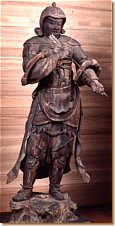 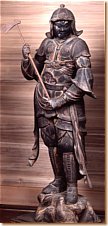 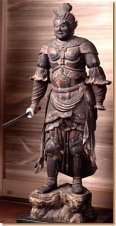
Heian Era wooden statues by Chosei, at Koryu-ji Temple in Kyoto
Above L to R: Anchira, Indara, Makora
Below L to R: Mekira, Sanchira
courtesy www.jinjapan.org
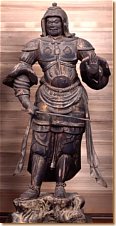 

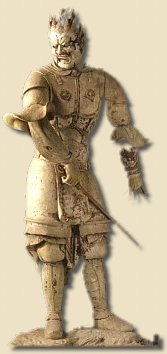 Below Text Courtesy of: Below Text Courtesy of:
JAANUS Online Dictionary
The twelve protective deities Yasha 夜叉 who accompany Yakushi 薬師. According to the sutra entitled YAKUSHI RURIKOUNYORAI HONGAN KUDOKUKYOU 薬師瑠璃光如来本願功徳経, upon hearing the Buddha expound the worthiness of Yakushi, these Yasha chanted his name and vowed to protect those who spread his sutra. Thus, they are specifically the protectors of those who are devoted to Yakushi and who chant the YAKUSHIKYOU 薬師経. Considered emanations of Yakushi, each of the twelve had 7,000 emanations, adding up to the number 84,000. Because the names of the Juuni Shinshou were transliterated from Sanskrit to Chinese, they tend to vary.
Although the appearance of the Juuni Shinshou is not described in the very early Chinese translation of the Yakushi-kyou, images appear to have been made in China from the Sui period (ca. 581-618) onward, and at an early point it appears that they were coordinated with the twelve emblematic animals, Juunishi 十二支. In Cave number 220 of the Tun huang Caves (Tonkou sekkutsu 敦煌石窟), carved in 642, the Juuni Shinshou who appear in the depictions of Yakushi's Pure Land Yakushi Joudo Hensou 薬師浄土変相 have animals on their crowns. In Japan the association of the Juunishi and the Juuni Shinshou appears in both the iconographic manuals KAKUZENSHOU 覚禅抄 and ASABASHOU 阿婆縛抄; while the Yakushi Nyorai Koushiki 薬師如来講式, written by Saichou 最澄, mentions that the Juuni Shinshou have jursidiction over the twelve hours. Although one might expect the earliest representations of the Juuni Shinshou in Japan to show the animals of the Juunishi, they are not indicated in either the Houryuuji Kondou 法隆寺金堂 painting or the Shin'yakushiji 新薬師寺 sculptures. Instead, they appear from the Kamakura period on, when the Juuni Shinshou linked to the function of the Juunishi, protected time (i.e. twelve hours, twelve days and twelve months) as well as ritual space.
The earliest representations of the Juuni Shinshou in Japan are the four figures painted in Yakushi’s Pure Land on one wall of the Houryuuji Kondou. There are records that indicate that eight figures were part of the sculptural group that forms the Yakushi Joudo in the five-story pagoda, Gojuu-no-tou 五重塔 of Koufukuji Temple 興福寺. The oldest extant sculptures of the Juuni Shinshou are from the Nara period set in Shin'yakushiji in Nara. There are also the late Heian period relief sculptures at Koufukuji 興福寺. There are also sculptures (1064) by Chouzei 長勢 in Kouryuuji 広隆寺, and the Kamakura period sculptures in the Toukondou 東金堂 of Koufukuji. Paintings include the Youchi-in 桜池院 Yakushi Juuni Shinshou from the end of the Heian period. From the Kamakura period on representaions of the Juuni Shinshou were common. <end JAANUS quote>

Below Text Courtesy of:
www.healing-touch.co.uk
They are sometimes said to protect the faithful through the hours of the day, the months and the directions of space. They wage war on sickness and are said to command the 80,000 pores of the skin. They are said to relate to each of the twelve vows of Bhaisajyaguru (Yakushi Nyorai).
In some traditions, the twelve warriors are believed to protect the faithful by presiding over the daylight hours, the months, and the directions of space. There are typically twelve, but sometimes only nine, generals whose armies wage war on sickness. These twelve warriors are also representative of the twelve vows of Bhaisajyaguru. Although described in Sanskrit, Chinese and Japanese texts, the attributes assigned to them, as well as their colours (and sometimes their names), may vary.
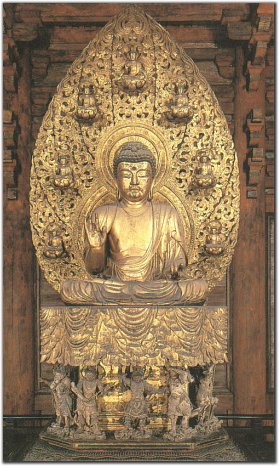
Yakushi Nyorai with 12 Generals at base.
Yakushi is flanked by Nikkō and Gekkō (not shown in above photo).
Tōji Temple 東寺 (Kyoto), Wood, dated 1603. Carved by Kōshō 康正 (1534-1621).
Photo courtesy of healing-touch.co.uk
Click here for quick photo tour of their site

  JUNI SHI - 12 Astrological “ZODIAC” Animals JUNI SHI - 12 Astrological “ZODIAC” Animals
Click here for more information (origin China)
In Japan, by the end of the Heian Period, these twelve generals become associated with the twelve animals of the twelve-year cycle based on the twelve divisions of heaven in ancient Chinese astronomy. As a result, in Japan, it is not uncommon to see depictions of the Twelve Generals with the astrological animals in their headdresses. See M. W. de Visser's charts relating the twelve Yaksa to zodiacal signs in Ancient Buddhism in Japan, Vol. II (Leiden: 1935, pp. 551-553)
- rat (Kubira, Kumbhira)
- ox (Basara, Bazara, Bajira, Vajra)
- tiger (Mekira, Mihira)
- rabbit (Anchira, Andira)
- dragon (Anira, Anila)
- snake (Sanchira, Sandilya)
- horse (Indara, Indra)
- sheep (Haira, Pajra)
- monkey (Makora, Mahoraga)
- rooster (Shindara, Sindura)
- dog (Shotora, Catura)
- boar (Bikara, Vikarala)
Each animal represents one year of a twelve year cycle. It also represents a day in a twelve-day cycle, and a two-hour period in each day, and a compass direction (not shown in above chart). There are different naming conventions, and sometimes the 12 Generals are associated with a different animal than listed above. For example, below is another common grouping that differs from the above list:
- Bikara Taisho - rat
- Shotora Taisho - ox / bull
- Shindara Taisho - tiger
- Magora Taisho - rabbit
- Haira Taisho - dragon
- Indara Taisho - snake
- Sanchira Taisho - horse
- Anira Taisho - sheep (or ram)
- Anchira Taisho - monkey
- Mekira Taisho - cock / rooster
- Basara Taisho - dog
- Kubira Taisho - boar
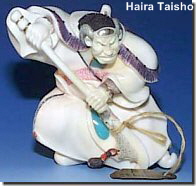 Below is yet another grouping, which comes from Kakuonji Temple in Kamakura. The temple possesses life-size wooden statues of all 12, reportedly carved in the Muromachi Period, sometime around 1401-1411 AD. Below is yet another grouping, which comes from Kakuonji Temple in Kamakura. The temple possesses life-size wooden statues of all 12, reportedly carved in the Muromachi Period, sometime around 1401-1411 AD.
- Kubira - rat
- Catura - ox
- Shindara - tiger
- Makora - rabbit/hare
- Haira - dragon
- Indara - snake
- Sanchira (Sandira) - horse
- Anira - sheep
- Anchira - monkey
- Mekira - rooster
- Bachira -dog
- Bikara -boar
Click here for details on the 12 astrological zodiac animals.

|
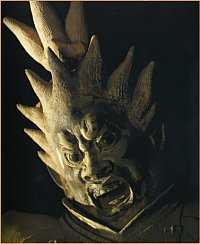
Kubira 宮毘羅
One of 12 Heavenly Guardians
Clay 塑像 & paint (saishiki 彩色)
H = 165.1 cm standing statue.
Above we present only
a closeup of the face.
Shin-Yakushiji Temple 新薬師持
Nara Era
Photo: Ogawa Kouzou
|
|
 Kubira 宮毘羅. Also known as Kompira or Konpira 金比羅. Synonymous with Konpira 金比羅 shrines (Kompira 金比羅 shrines, Hitohira 琴平 shrines, or Kotohira 琴平 shrines). They are devoted to Konpira, a local Shinto kami 神 (deity) worshipped as the guardian deity for seafarers, navigation, fishing, and water for agriculture. Konpira’s Buddhist counterpart is Kubira 宮毘羅, the leader of Yakushi Buddha's Twelve Heavenly Generals (Jūni Shinshō 十二神将), and also one of the Sixteen Protectors of Shaka Nyorai (Jūroku Zenshin 十六善神). The main shrine is situated on Mt. Zōzusan 象頭山, a maritime location in Kagawa Prefecture (Shikoku Island), where locals fondly call the deity and shrine “Konpira-san” or “Konpira Daigongen” and claim his cult dates back centuries before the introduction of Buddhism to Japan. But, says JAANUS; “According to legend, Konpira flew from India to a sacred cave at Matsuodera Temple 松尾寺 on Mt. Zōzusan 象頭山 (lit. Elephant's Head Mountain), a small mountain near the sea on Shikoku island, and became the temple's protective deity. He is worshipped principally as a seafaring god and secondarily as a god of water for agriculture. He may appear as a snake or as a dragon god (Ryūjin 竜神) and he is also identified with Ōmononushi 大物主神, the Shintō kami of Mt. Miwa 三輪. In the Edo period, Zōzusan was a famous Shugendō 修験道 site (ascetic mountain practices associated with the legendary founder En-no-Gyōja 役行者), and as a result it became a popular Shintō-Buddhist pilgrimage site. In the Meiji period (1868), the site was converted to a Shintō shrine in line with government policies to suppress Shugendō practice and Buddhist faith. The original Matsuodera Temple was therefore renamed Kotohiragū Shrine 金刀比羅宮 and the Konpira deity renamed Ōmononushi no Kami (aka Ōmononushi no Mikoto, aka Ōkuninushi 大国主命, aka Great Land Master). In spite of this, the principal image of the shrine remains that of the Buddhist deity Konpira, who today remains the central deity (shintai 神体) of Kotohiragū Shrine.” <end quote by JAANUS>. Kubira 宮毘羅. Also known as Kompira or Konpira 金比羅. Synonymous with Konpira 金比羅 shrines (Kompira 金比羅 shrines, Hitohira 琴平 shrines, or Kotohira 琴平 shrines). They are devoted to Konpira, a local Shinto kami 神 (deity) worshipped as the guardian deity for seafarers, navigation, fishing, and water for agriculture. Konpira’s Buddhist counterpart is Kubira 宮毘羅, the leader of Yakushi Buddha's Twelve Heavenly Generals (Jūni Shinshō 十二神将), and also one of the Sixteen Protectors of Shaka Nyorai (Jūroku Zenshin 十六善神). The main shrine is situated on Mt. Zōzusan 象頭山, a maritime location in Kagawa Prefecture (Shikoku Island), where locals fondly call the deity and shrine “Konpira-san” or “Konpira Daigongen” and claim his cult dates back centuries before the introduction of Buddhism to Japan. But, says JAANUS; “According to legend, Konpira flew from India to a sacred cave at Matsuodera Temple 松尾寺 on Mt. Zōzusan 象頭山 (lit. Elephant's Head Mountain), a small mountain near the sea on Shikoku island, and became the temple's protective deity. He is worshipped principally as a seafaring god and secondarily as a god of water for agriculture. He may appear as a snake or as a dragon god (Ryūjin 竜神) and he is also identified with Ōmononushi 大物主神, the Shintō kami of Mt. Miwa 三輪. In the Edo period, Zōzusan was a famous Shugendō 修験道 site (ascetic mountain practices associated with the legendary founder En-no-Gyōja 役行者), and as a result it became a popular Shintō-Buddhist pilgrimage site. In the Meiji period (1868), the site was converted to a Shintō shrine in line with government policies to suppress Shugendō practice and Buddhist faith. The original Matsuodera Temple was therefore renamed Kotohiragū Shrine 金刀比羅宮 and the Konpira deity renamed Ōmononushi no Kami (aka Ōmononushi no Mikoto, aka Ōkuninushi 大国主命, aka Great Land Master). In spite of this, the principal image of the shrine remains that of the Buddhist deity Konpira, who today remains the central deity (shintai 神体) of Kotohiragū Shrine.” <end quote by JAANUS>.
Kotohiragū Shrine was an important pilgrimage site for Emperor Sutoku 崇徳天皇 (1119 – 1164), the 75th emperor of Japan. It became an especially popular pilgrimage site in the 14th century, and remains very popular even today. The approach requires the pilgrim to climb 785 stone steps to get to the main sanctuary. Mt. Zōzusan, where it is located, is only 531 meters above sea level. But the shrine is only half way up Mt. Zōzusan. Altogether, pilgrims must climb 1,368 stone steps to arrive at the inner shrine. Kotohira is also called Konpira Mōde 金毘羅詣. A statue of the 11-Headed Kannon Bodhisattva (a designated Important Cultural Property) is located inside the shrine precincts.

LEARN MORE

|
|